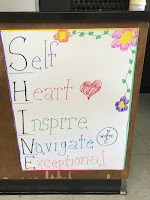One Upstander at a Time
Dear Readers,
One of the most influential books I have read in the past year would have to be Upstanders by Sara Ahmed and Harvey Daniels. I would highly recommend it to any educator.
We live in a global community in which we want our students to be empathetic, caring, innovative, thinking and knowledgeable individuals. That is just the tip of the iceberg.
As educators, we need to teach our young people skills and strategies to navigate a complex social networking world. It does not just "happen". Ahmed and Daniels offer fantastic lessons that can be integrated into any curriculum or instruction.
Roles in Society
After finding this incredible resource, I know start the year with lessons on roles in society. I love this lesson and it really encourages students to think about how actions, words and thoughts by characters and people help us make inferences regarding their beliefs, values and/or perspectives. It is always an enlightening and engaging discussion. It is so powerful as we continue to use the vocabulary throughout the year.
Identity
What makes an identity? How do we define ourselves? How do other people define us? Can identity ever be taken away?
I was talking to my 7th graders about how they might identify me as a teacher more often than a learner. They were surprised to learn, I actually consider myself a learner first. They only see me in one environment, that as the primary role of instructor (although I am trying to change this mindset), whereas I believe I spend more time being a student than I do a teacher. I love creating identity posters with them and see how they view themselves. It helps me to build relationships and get to know the whole child.
While reading about history and topics such as genocide, slavery, refugees, civil wars, etc. we discuss the horrific conditions that violate many basic human rights. I pose the question and ask them to reflect on, can identity be taken away? Do we have to internalize what others might "label" us or see us as? It's conversations like these that must be had.
Bullying
Following those ideas, we move into lessons on anti-bullying and becoming "upstanders". These include reflection on:
- What is your definition of a bully?
- Why do you think people bully?
- Why do you think people get bullied?
- How can bullying be prevented?
- What can you do if you witness bullying?
- How can bullying impact our local community? National community? Global community?
These always lead into natural topics of conversations regarding where/when bullying occurs, cyber-bullying and the effects of bullying such as suicide in extreme cases.
This year, I even had a few amazingly courageous students who shared their own experience of being bullied. I was so proud of them for giving us their perspective. My hope is to always create a safe environment where they feel they can empower others to stand up for themselves by sharing their own personal stories.
Empathy
Empathy can be difficult for adults to feel, let alone our teens whose entire worlds are based around their social circles! However, if given the language and resources, our teens are amazing individuals who can be incredibly empathetic towards others.
Last year I had a group of students in my room for lunch and all of a sudden another student burst into the room just sobbing. I watched them interact with her. They asked her if she was okay, what was wrong and put their hands out to comfort her with a touch on the arm/shoulder/back. An interesting detail to note was they were actually in a bit of a conflict with one another. Despite the fact that they were having some "social challenges", it still bothered them to see someone so upset.
When we provide students the opportunities to feel things from another's perspective, they can be very reflective. I have witnessed students almost stop in their tracks and have an "aha" moment of what it might be like to face hardships and life challenges they do not experience on a daily basis, if ever.
Final Thoughts
I have always taught with the whole child in mind, but Upstanders has really pushed and challenged my thinking to go above and beyond. Sara, you are an absolute delight to share ideas with and I thank you, from the bottom of my heart, for all that I have learned from you. You have impacted my students in ways that you will never know.
Warmly,
Teresa




























